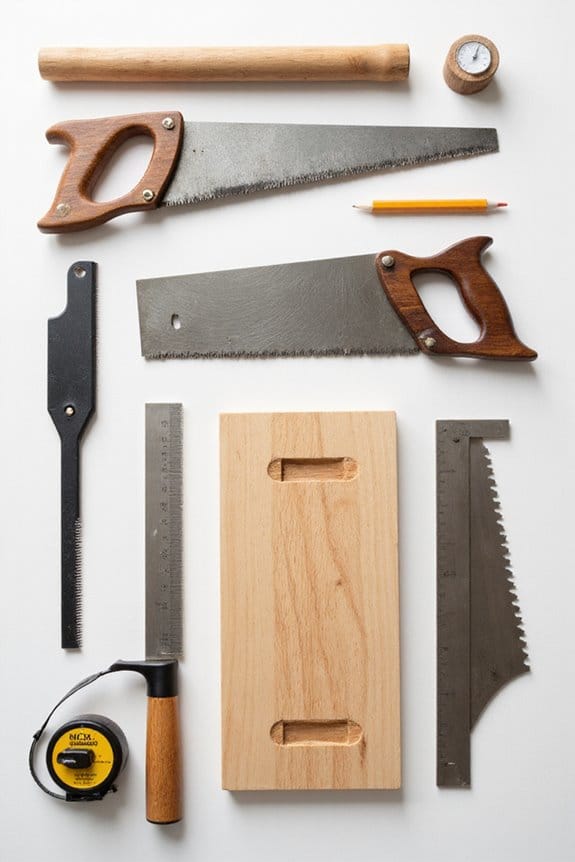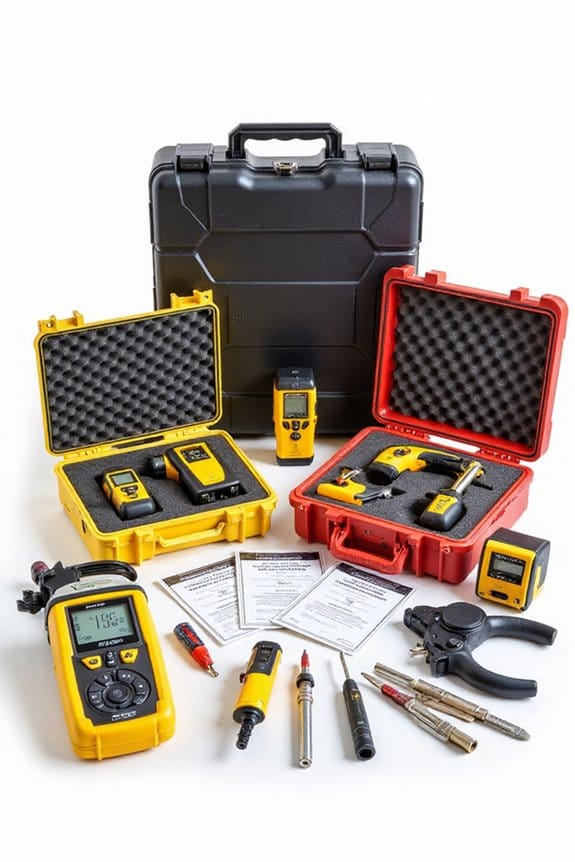The main difference between Phillips and flathead screwdrivers lies in their design and functionality. Phillips screwdrivers have a cross-shaped tip, which provides better grip and torque. They’re great for modern screws that need a little extra engagement. Flathead screwdrivers, on the other hand, have a straight blade for simpler tasks but require precise alignment to avoid slipping. If you’re unsure which one to use for your next project, stick around—I’ve got plenty more tips to share!
Key Takeaways
- Phillips screwdrivers have a cross-shaped tip for better torque, while flathead screwdrivers feature a straight blade for single horizontal slots.
- Phillips screwdrivers provide self-centering capabilities, making them easier to engage at angles compared to flatheads, which require precise alignment.
- The ergonomic tri-lobe design of Phillips screwdrivers enhances grip and reduces slippage, while flatheads can be clumsy during use.
- Phillips screws distribute torque efficiently and reduce damage, whereas flathead screws risk slipping if not aligned correctly.
- Each screwdriver type has specific applications; Phillips is ideal for modern furniture assembly, while flatheads excel in carpentry and electrical tasks.
Definition and Basic Design

When it comes to screwdrivers, knowing the difference between Phillips and flathead designs is essential for any DIY enthusiast. Here’s a quick breakdown of these screwdriver types and their design features:
- Phillips Screwdriver: This has a cross-shaped tip that fits into cross-slotted screws. Its tri-lobe design gives a solid grip, reducing slippage. Common sizes range from #0 to #4, with ergonomic handles for comfort.
- Flathead Screwdriver: It features a simple straight blade that fits into a single horizontal slot. While basic, it requires precise alignment to avoid slipping. The handle is usually cylindrical, allowing for easy torque application.
In my experience, having both types handy makes tackling projects much easier. Trust me, you’ll thank yourself later!
Functional Differences
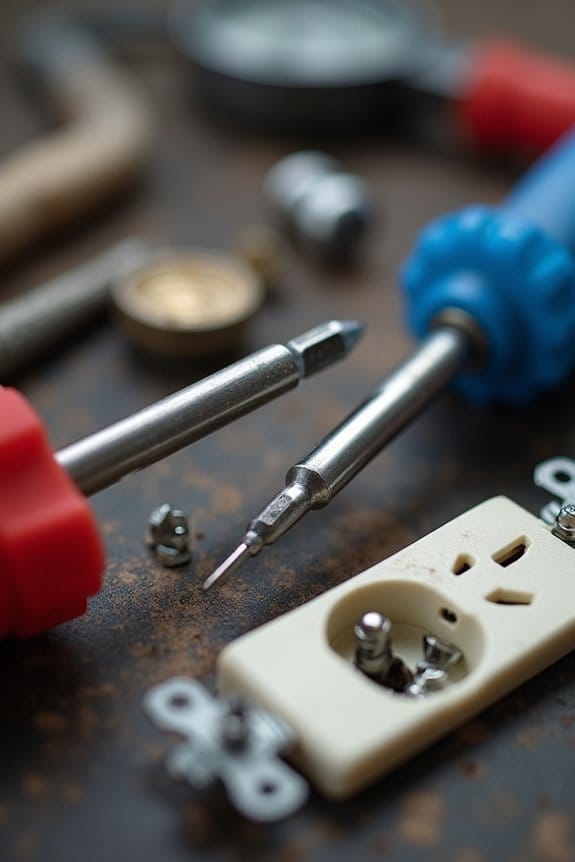
Understanding the functional differences between Phillips and flathead screwdrivers can really make your DIY projects smoother. Here’s a quick breakdown:
- Torque Efficiency: Phillips screwdrivers deliver better torque due to their cross-shaped tip, ensuring a solid grip. Meanwhile, flatheads can slip more easily, especially under high torque.
- Self-Centering: Phillips tips self-center, allowing for easy engagement even at slight angles. Flatheads need precise alignment, or you risk stripping screws—nobody wants that!
- Screwdriver Ergonomics: The design of Phillips screwdrivers helps reduce slippage and damage, making them ideal for delicate tasks. Flatheads, while versatile, can be a bit clumsy.
Screw and Screwdriver Compatibility
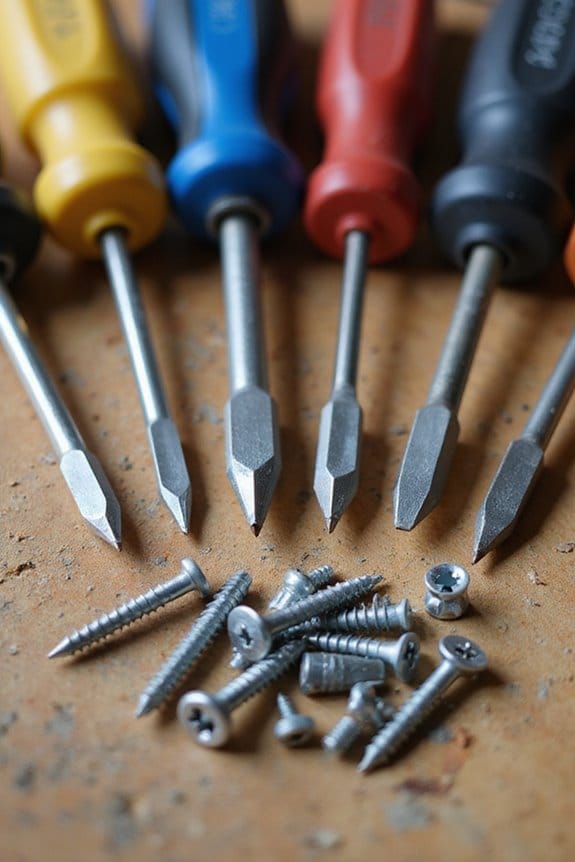
Screw and screwdriver compatibility can feel like a puzzle at times, but it’s essential for getting the job done right. Here are some key points to remember:
- Proper Fit: Always choose a screwdriver that matches the screw dimensions. A snug fit prevents slipping and damage.
- Phillips vs. Flathead: Phillips screws have cross-shaped recesses, allowing for better torque distribution. Flathead screws? Well, they’re simpler but can slip if not aligned properly.
- Bit Sizes: Invest in a set of bits that includes various sizes. This helps you tackle different screw dimensions with ease.
- Torque Control: Phillips screwdrivers cam out under excess torque, which can be helpful in avoiding overtightening.
Common Uses and Applications
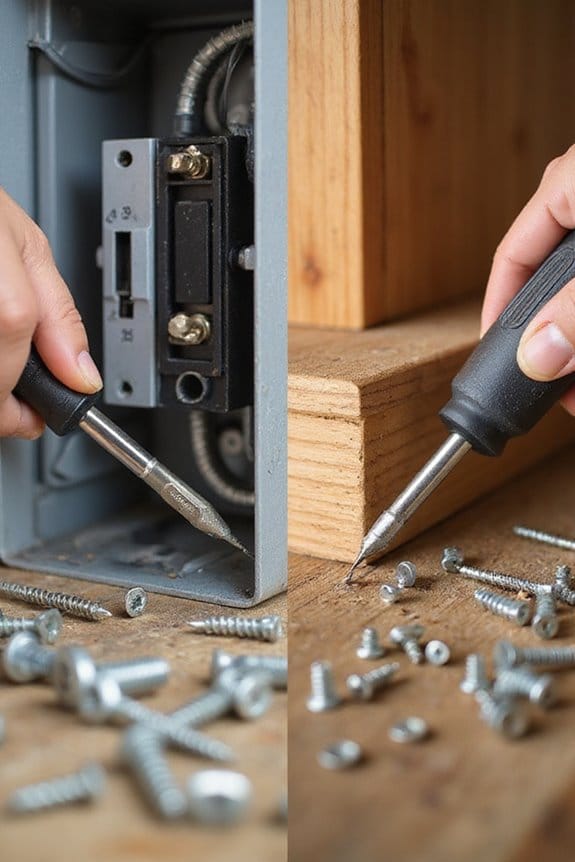
Choosing the right screwdriver can make all the difference in your projects. Here’s how I see the common uses for Phillips and flathead screwdrivers:
- Carpentry Tasks: Flathead screwdrivers shine in installing or removing wood screws. They’re essential for securing flathead screws in furniture and cabinetry.
- Electrical Applications: Flathead drivers are great for terminal screws, while Phillips screwdrivers dominate in appliances and electronics, preventing slippage during repairs.
- General Repairs: Flathead screwdrivers are handy for simple tasks, like loosening light switch plates.
- Furniture Assembly: I prefer Phillips for that firm grip on modern screws—no more battling with a slipping screwdriver!
In short, knowing when to use each type can save you time and frustration. It’s like having the right tool for the right job!
Advantages and Disadvantages
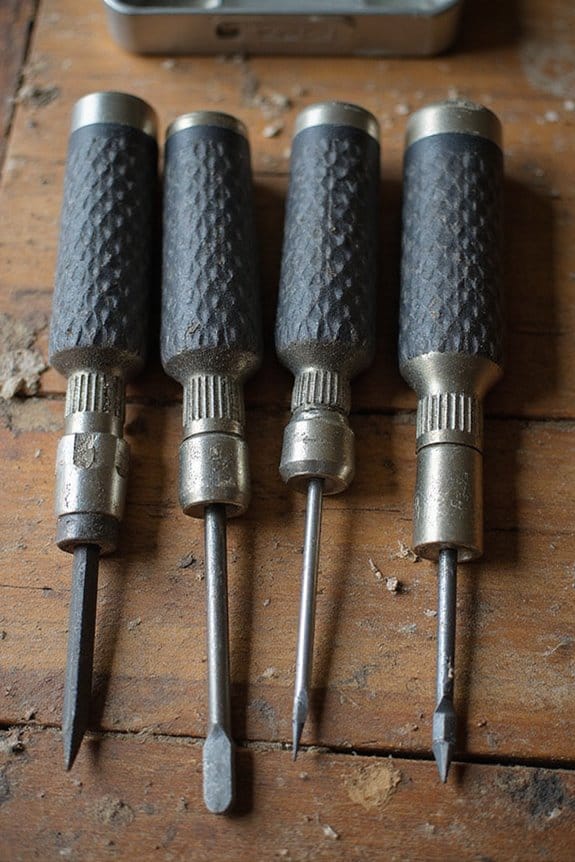
While both Phillips and flathead screwdrivers have their merits, each comes with its own set of advantages and disadvantages that can impact your projects. Here’s a quick rundown:
- Phillips Screwdrivers: They have an ergonomic design that improves grip and control. However, they require precise alignment and wear out faster, needing regular maintenance considerations to keep them effective.
- Flathead Screwdrivers: Their simple design allows for easy regrinding, extending their life. They can handle various tasks beyond driving screws, but they lack the cam-out feature, increasing the risk of overtightening.
Variety and Terminology Clarifications
When it comes to screwdrivers, understanding the variety and terminology can save you a lot of time and frustration. Here are some key points to take into account:
- Phillips Types: They range from #0000 to #5, with #2 being the most common for household projects. Larger sizes like #3 and #4 are great for heavy-duty tasks.
- Flathead Terminology: Also known as slotted screwdrivers, these have a simple flat tip. They come in various widths but lack a unified sizing system.
- Confusion Alert: The terms “Phillips” and “flathead” refer to both the tools and screws. Knowing this can help with tool selection and prevent accidental damage.
Historical Context and Evolution
The evolution of screwdrivers, particularly the Phillips and flathead varieties, is quite fascinating, especially since it all started way back in the early Middle Ages. Originally, screwdrivers were simple tools used to fasten wooden and metal parts. By the early 20th century, John P. Thompson’s recessed cruciform screw and driver changed everything. He aimed to improve torque distribution, but it was Henry Phillips who truly harnessed the design’s potential, especially in automotive manufacturing. The historical significance of this screwdriver evolution can’t be overstated—by 1940, 85% of U.S. manufacturers had adopted the Phillips design. While flathead screwdrivers served us well, the Phillips screw made assembly faster and more efficient. Who knew a little twist could have such a big impact?
Tips for Choosing the Right Screwdriver
Have you ever found yourself staring at a toolbox, wondering which screwdriver to grab? Let’s make that choice easier with these tips:
- Match the Tip Shape: Use flathead screwdrivers for straight slots and Phillips for cross-shaped ones. This helps avoid slipping.
- Consider Ergonomic Design: Look for screwdrivers with comfortable handles. Rubberized grips are great for delicate tasks, while sturdy materials work for heavy-duty jobs.
- Size Matters: Choose the right size to fit the screw slot perfectly. A mismatch can strip screws and waste your time.
- Think About Torque: If you’re dealing with tough materials, opt for a torque screwdriver. It’ll save you frustration and keep everything intact.
With these tips, you’ll be ready for any project that comes your way!
Frequently Asked Questions
Can I Use a Phillips Screwdriver for Flathead Screws?
I wouldn’t risk using a Phillips screwdriver on flathead screws; it’s like trying to fit a square peg in a round hole! Tool versatility is great, but screwdriver compatibility matters more for effective, damage-free fastening.
What Materials Are Phillips and Flathead Screwdrivers Typically Made From?
When I consider screwdriver materials, I notice Phillips screwdrivers often use copper beryllium for durability, while flatheads commonly feature alloy steels. Both types prioritize tool durability to withstand heavy usage and resist wear over time.
How Do I Maintain My Screwdrivers for Longevity?
I always focus on proper screwdriver storage and maintenance tips. Regular cleaning, inspecting for damage, and using dedicated organizers help me keep my tools in great shape, ensuring they last longer and work effectively.
Are There Electric Screwdrivers Designed for Phillips or Flathead Screws?
Yes, I’ve found that electric screwdriver types often cater to specific screw design compatibility. Most come with Phillips bits, while flathead options are available but less common. It’s great for versatility in various projects!
What Size Phillips and Flathead Screwdrivers Do I Need for Household Tasks?
When it comes to household projects, I’ve found that having a #2 Phillips and a few flathead screwdriver sizes (3 mm to 6 mm) handy makes all the difference for tackling various tasks effortlessly.




